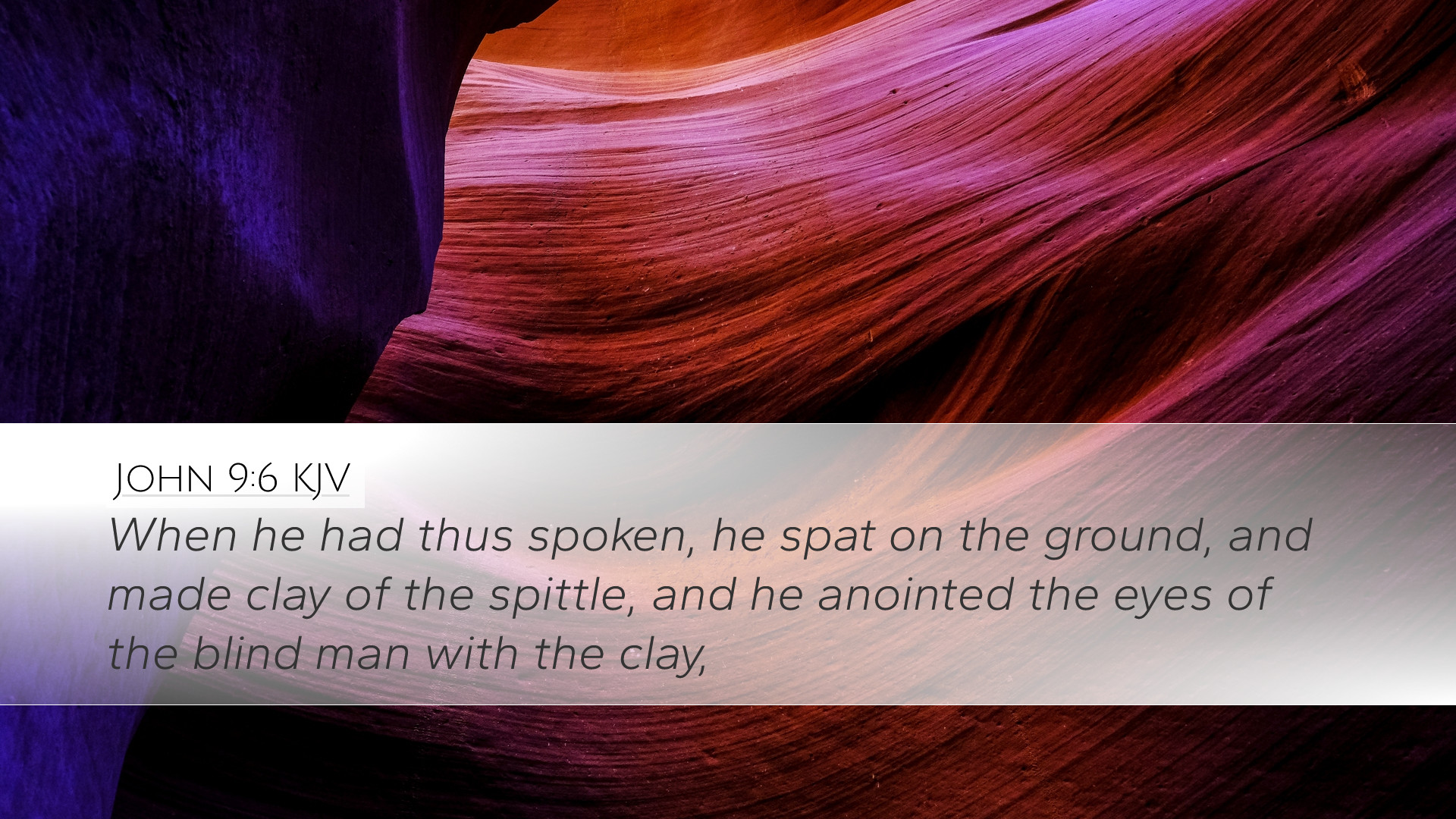Commentary on John 9:6
Verse Context: John 9:6 states, “When he had said these things, he spat on the ground and made clay of the spittle; and he anointed the eyes of the blind man with the clay.” This event is significant both in the narrative of Jesus’ ministry and in the theological implications regarding sin, healing, and the identity of Christ.
Introduction
This passage portrays Jesus performing a miraculous healing, encapsulating profound spiritual truths. Various theological perspectives emerge when examining this verse across reputable public domain commentaries. Here, we synthesize insights from Matthew Henry, Albert Barnes, and Adam Clarke to delve deeper into the main themes and lessons presented in this remarkable event.
Key Themes and Insights
The Act of Creation
Matthew Henry emphasizes the creative aspect of Jesus' act. By using clay, He reminds us of God's initial act of creation in Genesis, where man was formed from the dust of the ground. This notion links the physical healing with spiritual rebirth and creative power, indicating that just as God created man, He has the authority to restore him.
Albert Barnes notes the symbolic element in mixing clay with spittle to create the ointment. This action is seen as an illustration of God’s tender involvement with humanity; He utilizes common elements of the earth to perform extraordinary miracles, illustrating the divinity intertwined with humanity.
Theological Implications of Spittle
Adam Clarke elucidates the significance of the saliva used in the mud. Saliva has been viewed as a form of life-giving sustenance, and its use implies that healing flows from Christ as the source of life. Clarke points out that ancient beliefs attributed healing powers to spittle; thus, Jesus’ action resonates with those cultural perceptions while transcending them through divine authority.
Authority of Christ
Matthew Henry elaborates on the authority of Christ as the Divine Healer. The act reflects not only His miraculous power but also His willingness to engage personally with the afflicted. By anointing the blind man's eyes, Jesus illustrates how He personally reaches out to restore what sin has marred.
Albert Barnes reinforces this notion, reflecting on how the act of anointing signifies the restoration not just of sight but of dignity and wholeness. Jesus' ministry highlights that God's authority extends to all aspects of human life, including physical, emotional, and spiritual realms.
Symbolism of Blindness
The physical blindness of the man serves as a metaphor for spiritual blindness. Matthew Henry outlines how the blind man's condition symbolizes the spiritual blindness of many who are ignorant of their sin and need for salvation. In contrasting the physical sight restored with the implications of spiritual enlightenment, Henry calls attention to Jesus as the Light of the World.
Adam Clarke draws parallels between the man's physical restoration and the spiritual enlightenment available to all who believe. The act serves as a powerful reminder that recognition of one’s spiritual condition is often a necessary precursor to receiving divine healing.
Faith and Obedience
Albert Barnes brings forth the theme of faith and obedience. The blind man did not resist or question the method Jesus chose; instead, he submitted to the instruction given. Barnes notes the importance of faith in the healing process and argues that it serves as a model for believers today—emphasizing that obedience to Christ's directives often precedes miraculous works in our lives.
Matthew Henry adds that, although the blind man initially lacked physical sight, he acted in faith, demonstrating that true insight begins in the heart’s willingness to obey God’s word. This emphasizes God's desire for a relationship based on faith, highlighting that faith leads to revelation.
Transformation and Testimony
The act culminates in a significant transformation of the man's life. Adam Clarke points out that the man's transformation from blindness to sight not only affects him personally but also serves as a powerful testimony to those around him. The event shapes the man's identity and becomes a means to reveal the character of Christ to others.
Matthew Henry reinforces this, reminding us that the witness of a transformed life is a potent testimony. The blind man’s testimony of seeing through perhaps the most unconventional means signifies that God often works in ways that confound expectations, ultimately glorifying His name and drawing others to Him.
Conclusion
In summary, John 9:6 encapsulates a multifaceted encounter that is rich in theological implications. Jesus’ method of healing through clay reminds us of His divine authority and creative power, while inviting reflection on spiritual sight and faith. The incident not only highlights personal transformation but also serves as a vital lesson on obedience and witness for those who follow Christ. Believers are encouraged to recognize their own spiritual blindness and to rely on Christ for restoration—knowing that in Him, “the light shone in the darkness, and the darkness did not overcome it” (John 1:5).


